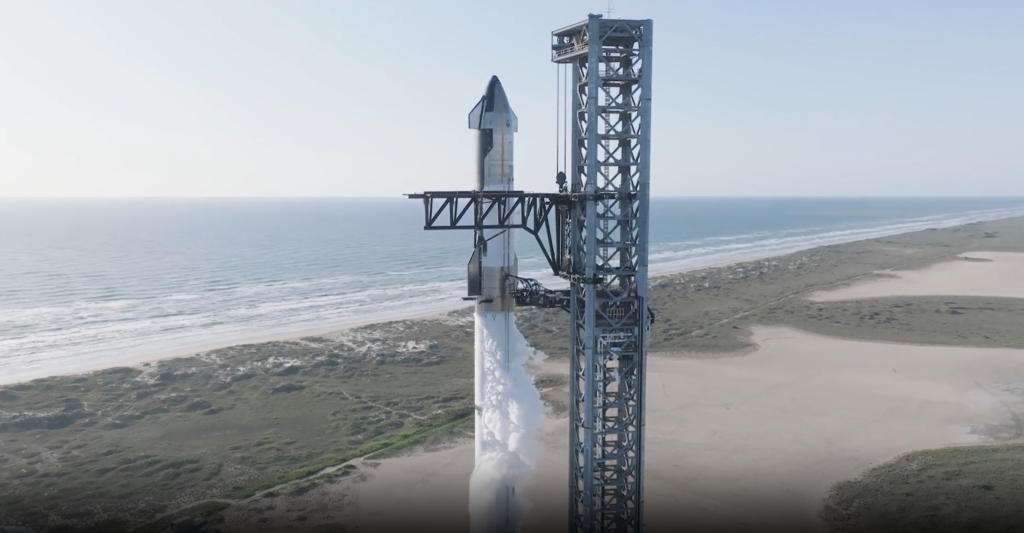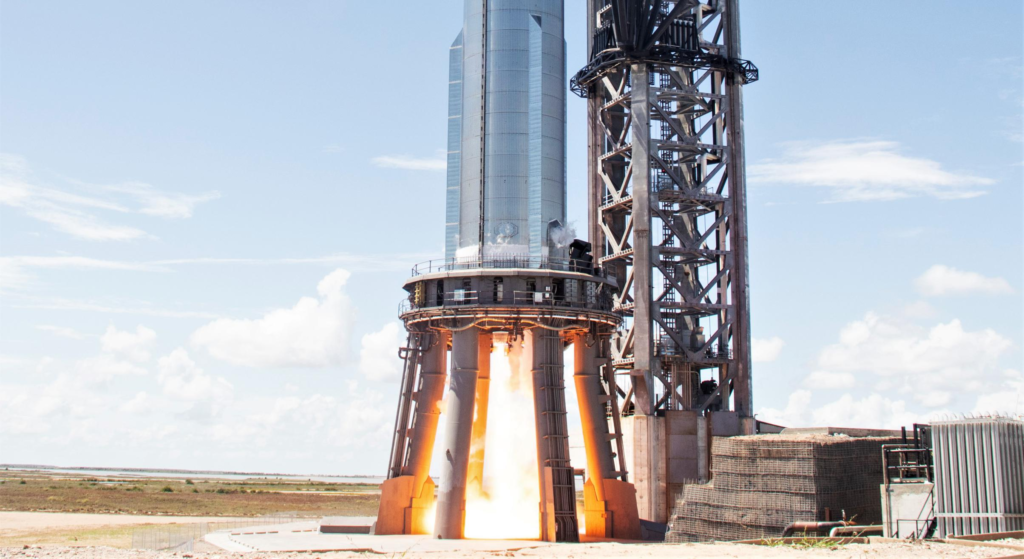
How Exactly SpaceX Plans To Repair The Pad & Launch Starship
Just days ago the first launch of Starship marked one of if not the biggest moments in the program’s history. However, with this launch now complete, it brings up the question of what is next for Starship and Starbase in particular. A lot of things have changed in a short period of time including damage to important infrastructure at the site, and the use of both Booster 7 and Ship 24, just to name a few.
All this being said, SpaceX is still confident that in just a few months’ time they will be ready to launch again. Recently, we have learned more about the company’s plan to repair the orbital launch mount and install a unique system to withstand and deflect the power of Super Heavy’s 33 Raptor engines. This is especially important after this one issue caused a ripple effect of other complications during the launch.
While SpaceX may have misjudged the impact this initial launch would have on Stage 0, they are ready to begin work and make it better than it was before. Here I will go more in-depth into the company’s plans for Stage 0, what improvements have been made to the next Starship test article, the future of this program, and more.
Stage 0 Plans

As many people have seen by now, the first launch of Starship caused a decent bit of damage to the surrounding pad infrastructure, otherwise known as Stage 0. For around 8 seconds Starship was on the pad firing its engines onto the concrete below. This ended up destroying the foundation of the mount and sending concrete projectiles in every direction at immense speeds. These projectiles are thought to have caused some damage to the Starship rocket itself as well as nearby pad structures such as the propellant tank farm.
Yesterday, Elon clarified with a tweet saying, “3 months ago, we started building a massive water-cooled, steel plate to go under the launch mount. Wasn’t ready in time & we wrongly thought, based on static fire data, that Fondag would make it through 1 launch. Looks like we can be ready to launch again in 1 to 2 months.” This tweet is very important, but there is a lot to unpack. For one, when Elon says they thought that the Fondag would make it through 1 launch, he’s referring to a unique type of concrete. Specifically, Fondag is a special type of concrete designed to be resistant to fire, abrasion, corrosion or thermal shock. Its formulated using specific aluminum oxide binders and synthetic aggregates. In other words, it’s a much stronger and more capable concrete mixture.
Unfortunately, as the recent launch demonstrated, it was no where near strong enough to resist the power of 33 Raptor engines firing at practically full thrust. This being said, SpaceX did have reason to believe that it could have held up based on recent static fires as mentioned in Elon’s tweet. Just months ago in February, while preparing for the recent full launch, SpaceX completed a 31 Raptor engine static fire of Super Heavy. In total, the static fire lasted around 7 seconds which was similar to the amount of time they expected Starship to be on the pad before liftoff. The main difference however was the thrust of the engines. During this test, the Raptor engines were not performing at the maximum thrust and instead were slightly toned down. While the pad below still sustained some minor damages, it’s likely that this gave SpaceX some confidence that the Fondag would at least, for the most part, withstand an actual launch attempt. Obviously, we know now that was not the case at all.
Another big part of this tweet was the solution that is expected to be ready in only a month or two. Here Elon referred to a massive water-cooled steel plate that would go under the launch mount. In regard to this, parts for the mentioned flame diverter have already been fabricated, and were seen and filmed on-site before the test flight occurred. This confirms that it was definitely in the works and already nearing completion however not quite fast enough for SpaceX. They decided to forego the extra system which ended up not being the best decision, but not catastrophic. From what we know, this system will consist of multiple large steel plates separated by spacers with water flowing in between as a coolant. In the coming weeks, it will be interesting to see how exactly SpaceX designs and angles this system under the Orbital Launch Mount.
Starship’s Future

Not only did we learn more about why SpaceX launched with just concrete under the rocket, and what system will soon replace this, but we also got an estimate from Elon that they will be ready to launch in 1-2 months. It’s important to point out that this number should be taken with a grain of salt as Elon is usually quite ambitious regarding future timeframes and deadlines. This being said, the next rocket and a lot of work is already well underway.
For example, in a recent interview, Elon said, “The funny thing is we are actually dying to get this rocket off no matter what happens to it because there are so many improvements between booster 7 and booster 9, literally hundreds. We moved from hydraulic thrust vector control to electric, the entire heat shield structure is completely redesigned and more.” Almost all of these changes are complete and ready to begin testing.
Although, before any testing can happen of these improved systems, the pad will need to be fixed which is a decent size job. In another tweet, Eric Berger reported that “The damage in Boca Chica at the Starbase launch site looks pretty serious, but a former senior SpaceXer from there says he believes the pad can be repaired; and a (water-cooled?) flame diverter installed in 4 to 6 months. Just passing on what I was told.” This time estimate could be much more realistic. A lot of work needs to be done at Stage 0 including fixing the massive crater and especially the mount itself. Various images highlight that the Raptor engines managed to strip the concrete from the surrounding foundation leaving just rebar behind. Unfortunately, it seems that in the coming months, the next rocket will be ready to begin testing but Stage 0 will not. Before this new water cooled steel plate can be properly installed, the entire launch mount will need work.
In addition to this, it’s very likely that we see a proper water deluge system installed as well. The primary reason for a water deluge system is to reduce extreme heat damage to the launch structure, however, it also serves to suppress sound waves that can damage the vehicle upon launch. In the past, we have seen SpaceX working on this exact system and beginning to receive parts for one.
As for a launch license, SpaceX should be in the clear going forward from Boca Chica. Since the 2022 Programmatic Environmental Assessment, SpaceX provided the FAA with additional information regarding Starship’s planned landing, Super Heavy’s planned soft water landing, and the Launch Pad Detonation Suppression System. The FAA published a Written Re-Evaluation which evaluated, based on this new information, whether supplemental environmental analysis is needed to support the FAA Office of Commercial Space Transportation decision to issue a vehicle operator license to SpaceX for the operation of the Starship/Super Heavy launch vehicle at its existing Boca Chica Launch Site in Cameron County, Texas. In the Written Re-Evaluation, the FAA concluded that the issuance of a vehicle operator license for Starship/Super Heavy operations conforms to the prior environmental documentation, that the data contained in the 2022 Programmatic Environmental Assessment remains substantially valid, that there are no significant environmental changes, and all pertinent conditions and requirements of the prior approval have been met or will be met in the current action. Therefore, the preparation of a supplemental or new environmental document is not necessary to support the Proposed Action.
In a statement, the FAA said, “After a comprehensive license evaluation process, the FAA determined SpaceX met all safety, environmental, policy, payload, airspace integration, and financial responsibility requirements. The license is valid for five years,” With this being the case, it’s now on SpaceX to prepare for the next launch. Going forward this should help significantly as the main factor will be how fast SpaceX can launch rather than regulations and approval.
It’s also important to point out that SpaceX is working on another site for Starship in Cape Canaveral. While Boca Chica and Starbase are great, the company sees this site as the early test grounds for Starship where they can rapidly iterate and blow up test articles. However, in the future, they see the site in Florida as the future of Stasrhip and consistent launch operations. Thankfully, as they build up that site, they will have invaluable information on what exactly works and doesn’t work when it comes to launch site infrastructure. Something we can look forward to not long from now.
Conclusion
SpaceX has a lot on its plate after the first launch of Starship. They know now that Fondag will not withstand even a single launch and a new system is needed. They will now work to repair the damage sustained to Stage 0 and install the proper systems to control the exhaust of the world’s most powerful rocket. We will have to wait and see how it progresses and the impact it has on the space industry.
